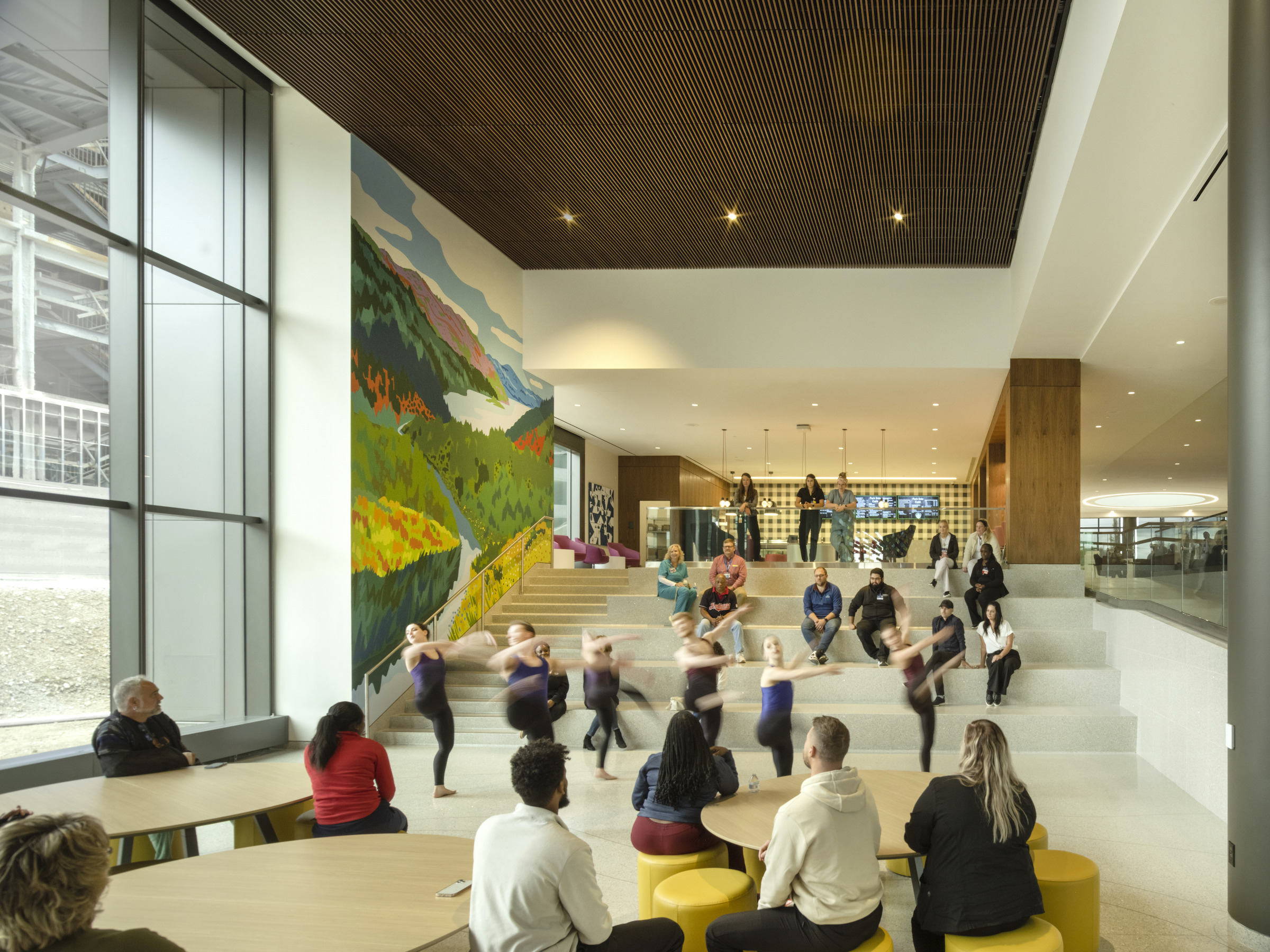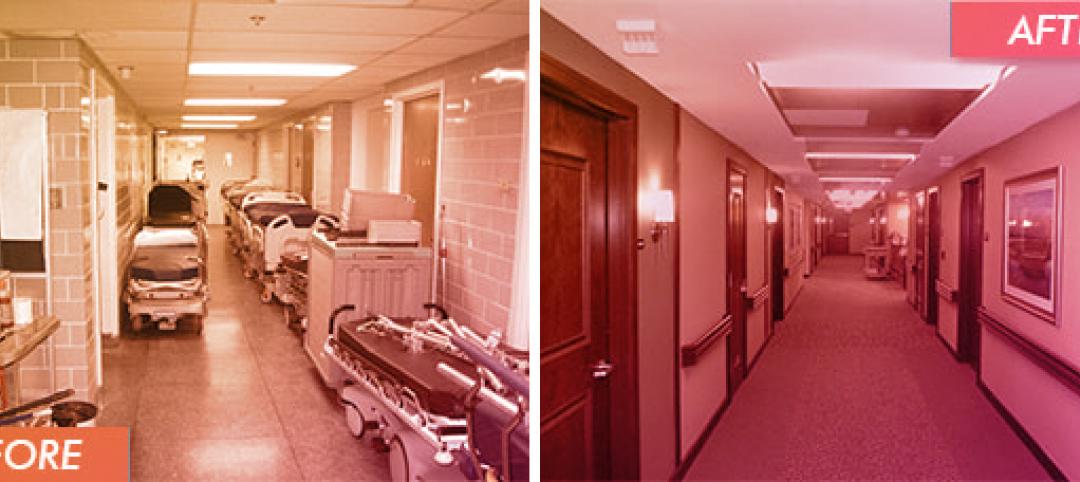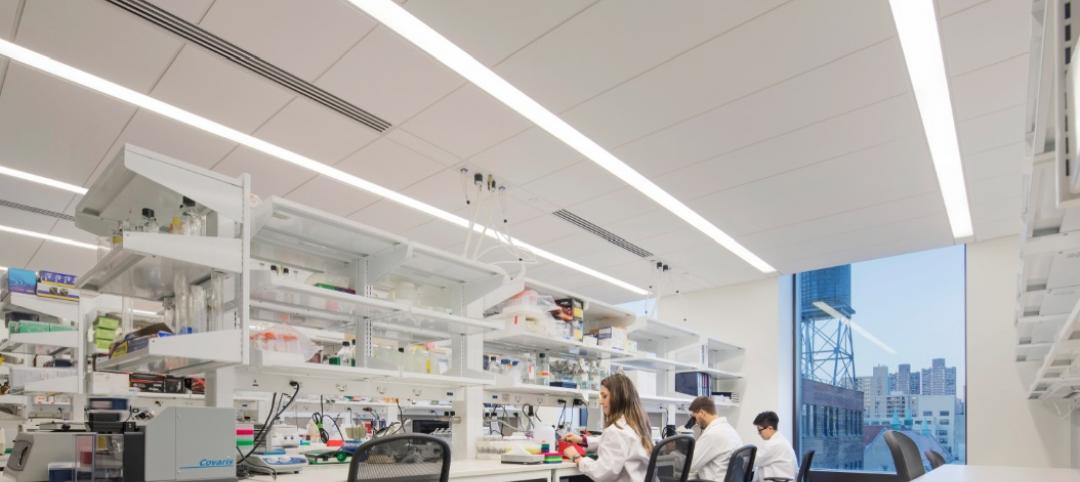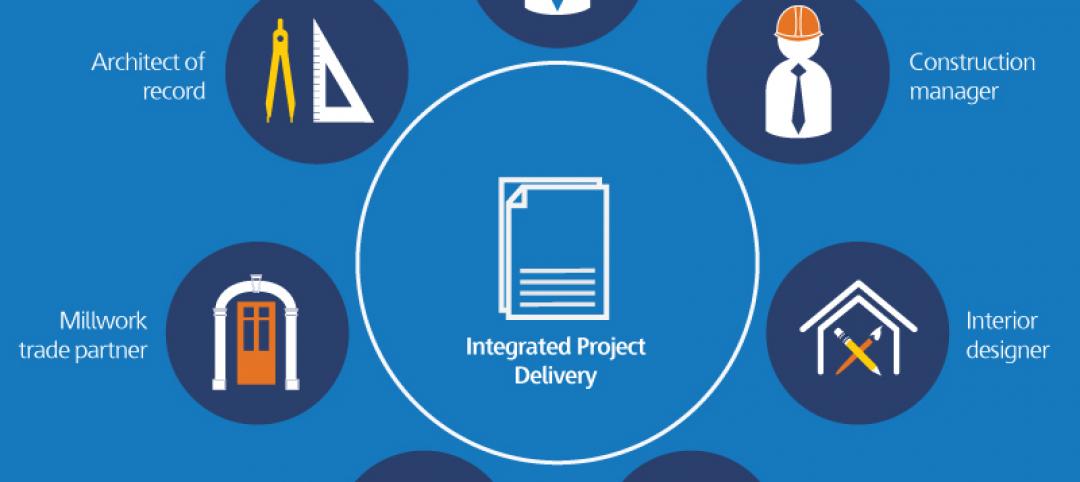The newly opened MetroHealth Glick Center in Cleveland, a replacement acute care hospital for MetroHealth, is the centerpiece of a neighborhood revitalization. The eleven-story structure is located within a ‘hospital-in-a-park’ setting that will provide a bucolic space to the community where public green space is lacking. It will connect patients, visitors, and staff to the emotional and physical benefits of nature.
The building’s design drew inspiration from photos of the first hospital on the site, which had originally been set in a park. The white terracotta exterior façade reflects the traditional material used on the MetroHealth Hospital at the beginning of the twentieth century. The innovative cladding system was prefabricated on the ground and hung from a unitized curtain wall system, making assembly safer and faster.
The wave-like profile of the terracotta panels echoes the nearby Lake Erie and Cuyahoga River. The panels have a more turbulent and textural response at the public interface at grade, and slowly become calmer as the building reaches toward the sky. The narrow end of the inpatient tower orients towards the residential Clark-Fulton neighborhood to reduce its visual impact and scale.
The interplay of light and shadow found in tree canopies is abstracted in the design through the texture of the building cladding, numerous skylights, and textured wall tile. The building responds to the lack of green space in the Clark-Fulton neighborhood to support informal park-like activities, through visual cues such as biophilia and the inclusion of a dedicated performance space in the public lobby. Green grass-like carpeting with undefined edges, cartography in the terrazzo, picnic patterns in the servery, and a large, simulated window with a view of Ohio landscape provide natural symbolism.
In the meditation area, a piece by local artist Susan Danko uses calming colors and leaf and branch forms to add to the feeling of serenity. These nature and park concepts extend to MetroHealth’s youngest patients in the Peds Platform, or Tree House—a play and breakout space for children to take their minds off being in the hospital. Inspired by an actual tree house, it was designed as an immersive jungle or forest canopy and includes an outdoor space. The Tree House provides children with a sense of freedom and control in a situation that can otherwise feel daunting.
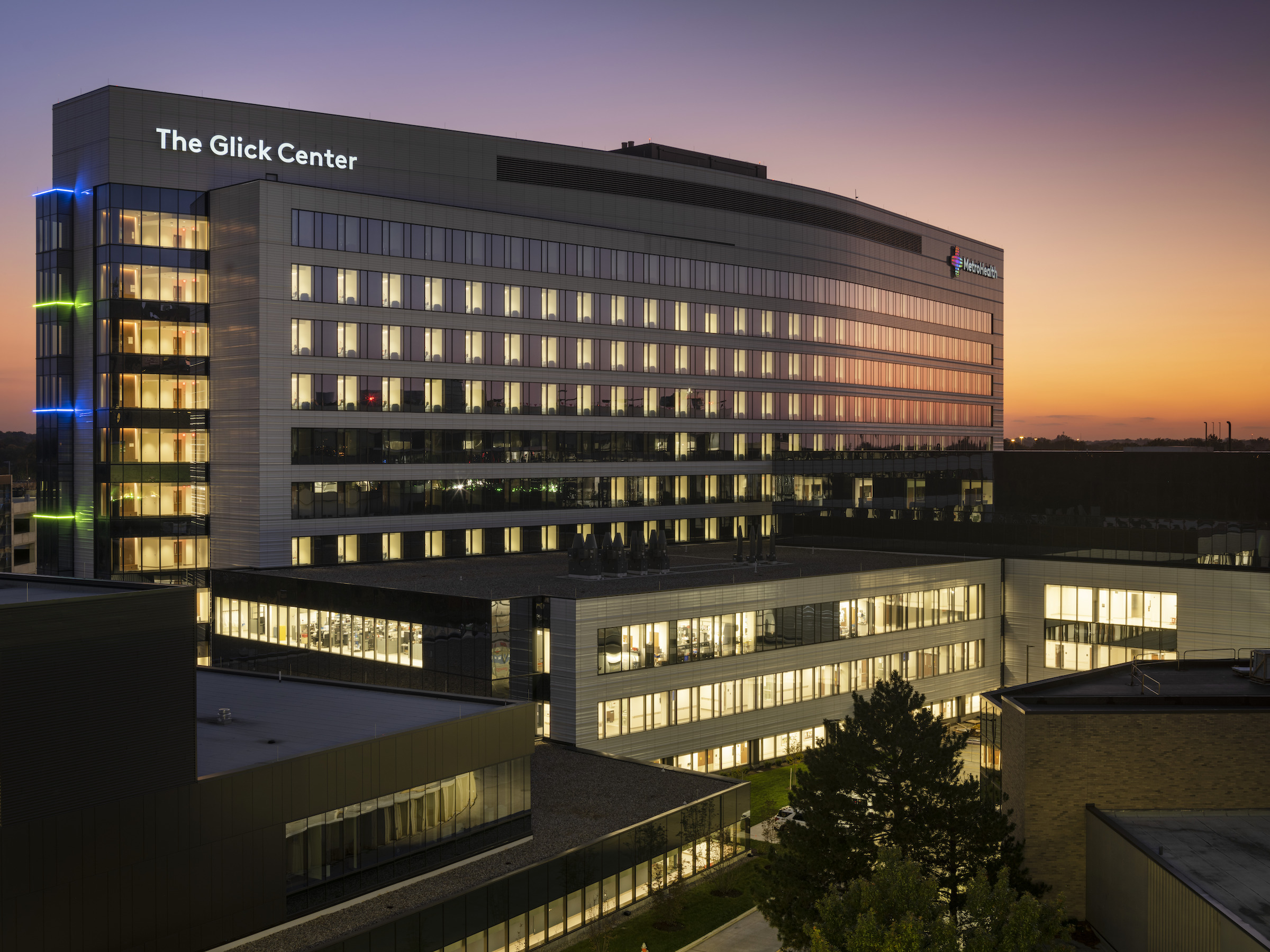
Space flexibility was prized during a “Process Neutral” design approach to allow the institution to respond rapidly to changes in patient care and to streamline staff efficiencies by responding to changes in acuity and operations over the building’s life. Fixed monuments are avoided in an open floor plate, and flexible open plans rather than overly customized space promote visibility and ease of access.
The hospital has 288 universal, private rooms with individual family waiting rooms on every floor. This family resource destination welcomes families and visitors, offers a variety of privacy levels, concierge level information services, and a kitchen for prepping meals.
The new hospital will be LEED certified and seek Well Building certification.
On the project team:
Owner and/or developer: MetroHealth System
Design architect: HGA
Architect of record: HGA
MEP engineer: HGA and Karpinski Engineering, Associate MEP Engineer
Structural engineer: HGA
General contractor/construction manager: Turner Construction
Civil engineer: HGA, EMH&T, Osborn Engineering
Plumbing Design: Sandhu & Associates
Associate Architect: Bostwick Design
Local Architecture Support: Makovich & Pusti Architects, Inc.
Here is the complete statement from HGA:
Nationally-recognized, interdisciplinary design firm HGA is pleased to announce the completion of MetroHealth System’s replacement hospital, The Glick Center, in Cleveland, Ohio. HGA reimagined the master plan of MetroHealth’s campus transformation, and led the planning, architecture, interior design, and engineering of the 11-story state-of-the-art acute care hospital, which accepted its first patients on Saturday, November 5, 2022. MetroHealth’s main campus is in the Clark-Fulton neighborhood, a community MetroHealth has served for more than 150 years. MetroHealth’s transformational campus plan emphasizes diversity, population health and research-based care. The new inpatient tower is cost-effective, sustainable, and patient focused. When the campus is complete, it will be grounded in a restored, natural urban setting.
More than eight years ago, in April 2014, Dr. Akram Boutros, MetroHealth President and CEO, announced plans for a new main campus hospital, financed by $946 million in hospital-revenue bonds and a $150 million fundraising campaign to support the campus’ expanded green space and community programs. And it was more than three years ago that the replacement patient tower—now named The Glick Center—broke ground.
The first EcoDistrict-certified hospital in the United States, MetroHealth represents a paradigm shift in how a healthcare facility can lead a neighborhood revitalization that focuses on health equity and community well-being. HGA and MetroHealth collaborated with many local partners and residents from the community to make the most meaningful, positive impact on Clark-Fulton. The medical center emphasizes research-based care within a ‘hospital in a park’ setting that connects patients, visitors, and staff to the health benefits of nature.
“Recognizing the importance of the Clark-Fulton neighborhood, we worked closely with MetroHealth and numerous partners to design and build a stunning hospital that blends arts and health, and will evolve with future innovations in clinical technology and advances in care,” said Mark Bultman, Principal on the project, and HGA’s Healthcare Market Sector Leader.
Healthcare Design Inspiration
The design of the building drew inspiration from historical photos of the first hospital, which had originally been set in a park. The white terracotta exterior façade reflects the traditional material used on the MetroHealth Hospital at the beginning of the twentieth century and was reimagined using contemporary building methods. The innovative cladding system was prefabricated on the ground and hung from a unitized curtain wall system, making assembly safer and faster. The wave-like profile of the terracotta panels echoes the nearby Lake Erie and Cuyahoga River. The panels have a more turbulent and textural response at the public interface at grade and slowly quiet as the building reaches toward the sky. The narrow end of the inpatient tower orients towards the residential Clark-Fulton neighborhood to reduces its visual impact and scale.
Numerous studies have found that recovery was faster and more complete when subjects were exposed to natural environments. The interplay of light and shadow found in tree canopies is abstracted in the design through the texture of the building cladding, numerous skylights, and textured wall tile. The building responds to the lack of green space in the Clark-Fulton neighborhood by becoming a ‘Hospital in a Park’ and ‘Hospital as a Park’ to support informal park-like activities, through visual ques such as Biophilia and the inclusion of a dedicated performance space in the public lobby for dynamic community performances. Additional park symbolism includes green grass-like carpeting with undefined edges, cartography in the terrazzo, picnic patterns in the servery, and a large simulated window with view of Ohio landscape. “Taking design inspiration from its culturally rich urban neighborhood on Cleveland’s West Side, we worked with HGA landscape designers to create a series of landscaped parks, inspired by the historical roots of the area, including industrial salt and gravel mounds,” said HGA senior designer Bryce Hubertz.
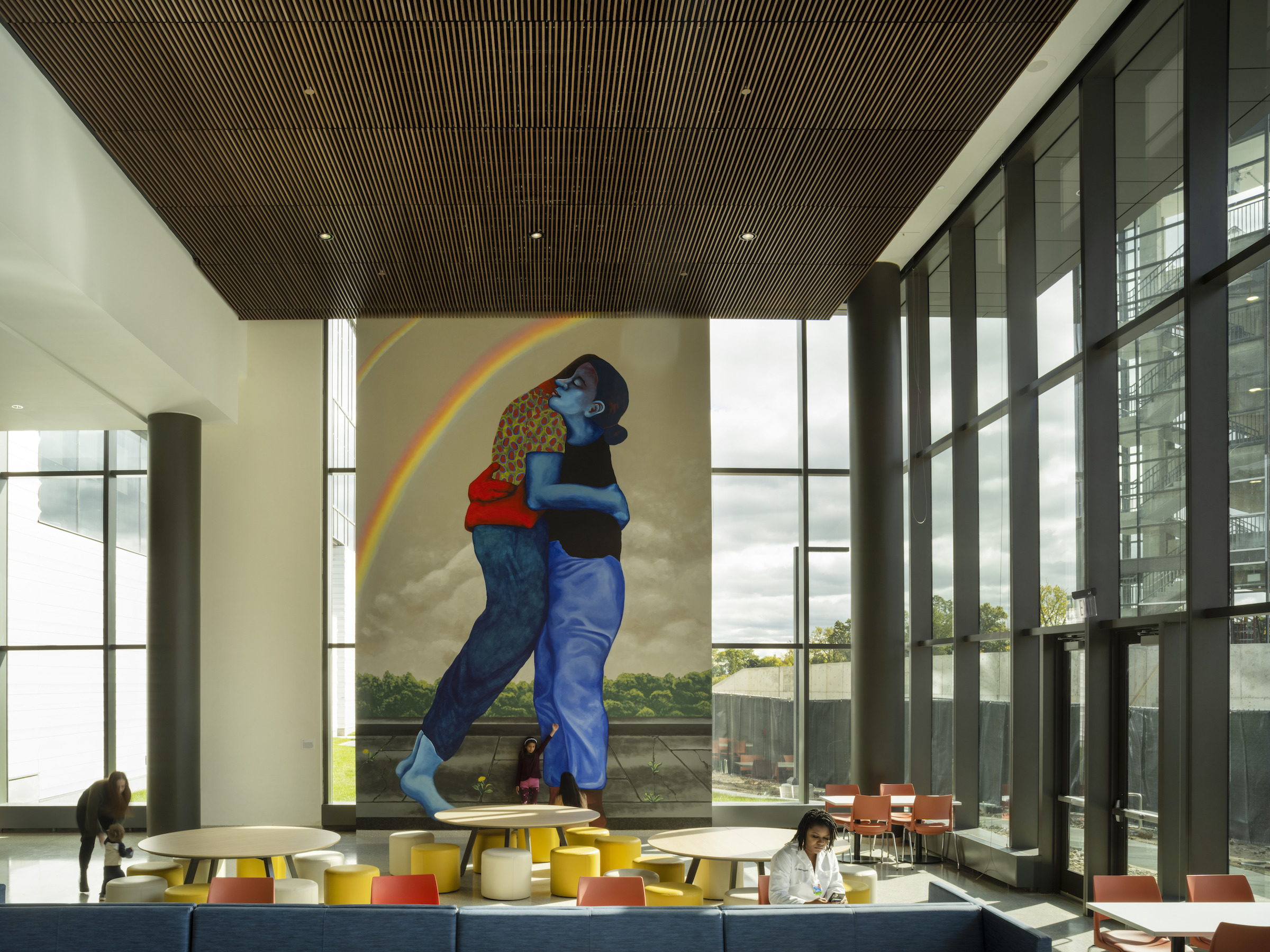
In MetroHealth’s meditation area, a piece by local artist Susan Danko uses calming colors and leaf and branch forms to add to the feeling of serenity in the space. These nature and park concepts extend to MetroHealth’s youngest patients. The Peds Platform, or Tree House, is a play and breakout space for children to take their minds off being in the hospital. The inspiration was an actual tree house, designed to feel immersed in a jungle or forest canopy, and includes an outdoor space. The Tree House provides children with a sense of freedom and control in a situation that can otherwise feel daunting.
Health, the Arts, and the Campus
MetroHealth is a pioneer in transforming health and healing through the Arts. It created The Center for Arts in Health in 2015, with a mission to embed visual, performing, and therapeutic arts throughout MetroHealth. MetroHealth is integrating an extensive art program throughout its new facility that benefits every staff member and visitor, from the youngest to oldest, and connects the hospital to the community. The new main lobby converts to an amphitheater for fine arts programs and performances that will please patients, families, and the public, who may not otherwise be exposed to these types of programs.
“MetroHealth Glick Center will benefit from an integrated approach to the arts and health through dedicated physical space and programs,” said Linda Jackson, Director, Center for Arts in Health at MetroHealth. “Whether it be music, dance, theater, visual arts, wall art installations, or community arts programs on nature, artists will be able to create a truly extraordinary experience for MetroHealth’s patients and community.”
The West 25th St corridor and the adjacent downtown neighborhoods have an abundance of colorful public murals used as a visual expression of Cleveland’s active culture. The hospital infuses these colors in dichroic partition glass and furniture within its public spaces to connect to its cultural context. On the main stairs, a bright and colorful mural by artist Ariel Lee depicts Ohio’s Cayuga Valley and connects to the park setting beyond. Cleveland artist, Lynnea Holland Weiss’ mural of two figures in an embrace emphasizes the support, hope, and healing nature of MetroHealth and will hang in the main dining space. A sculpture of acrylic discs by artist Emmanuelle Moureaux is suspended from the ceiling of the dining hall and mimics the sunlight that flows into the space through the large windows. Each piece selected by Linda Jackson and her team has a common theme: bright colors, positive imagery, and a nod to locality to help patients feel at home and find inspiration in their healing process.
Flexible Planning for Long Term Value
In a forward-thinking response to rapid changes in improved patient care and to streamline staff efficiencies, an evidence-based, lean, and data-driven planning approach led to a ‘Process Neutral’ Design approach.
288 universal, private rooms support excellence in care delivery today, while giving MetroHealth flexibility as changes in acuity and operations occur over the building’s life. Fixed monuments are avoided in an open floor plate, and traditionally overly-customized space is replaced by flexible open plans that also promote visibility and ease of access.
Walter Jones, Sr. Vice President, Campus Transformation at MetroHealth, said, “the process neutral approach elevates the hospital’s best practices, provides the most technologically advanced and compassionate patient care experience, and creates a flexible building that will adapt as care delivery advances.”
The placement of new interventional procedure rooms, Cardiac Catheterization Labs, and Endoscopy Procedure Rooms adjacent to the existing room surgical suite creates a flexible interventional platform. All-day stay patients are cared for in highly adaptable, universal Pre-op, PACU, and Phase II Recovery spaces that respond to changing census and patient needs. Room features afford privacy and hotel-like amenities for patients and families during their stay. The burn unit provides inpatient treatment and an outpatient clinic and shares a floor with the stem cell unit. The flexibility of the floor plate allows for a unique configuration of the core workspace to meet the unique needs of these departments.
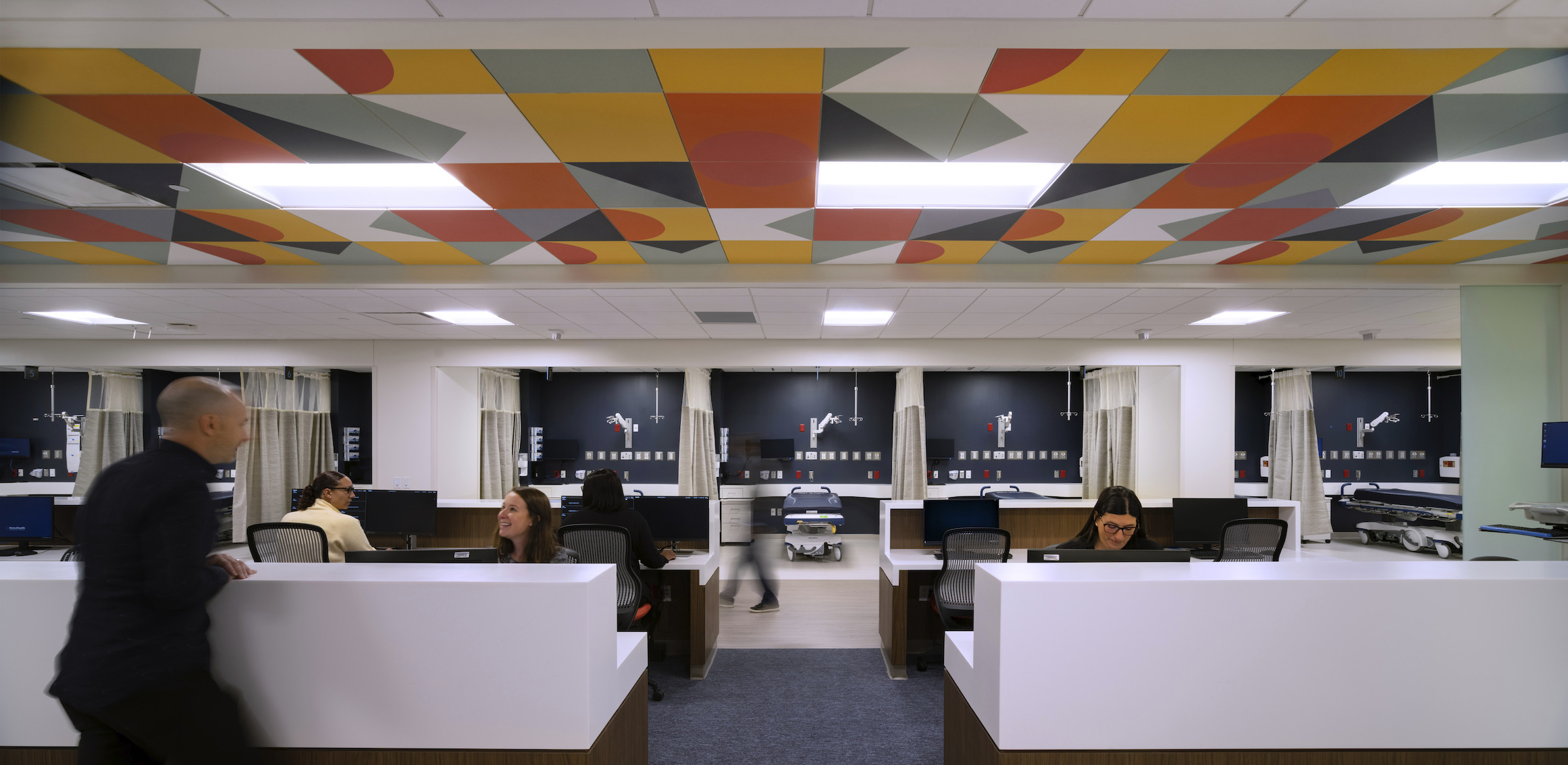
A singular Family Center replaces individual family waiting rooms on every floor. allowing even more flexibility to adapt patient floors when change inevitably comes. This family resource destination welcomes families and visitors, offers a variety of privacy levels, concierge level information services, and a family-like kitchen for prepping meals.
Hospital-Led Sustainability for the hospital
HGA reimagined the campus plan to create a ‘hospital in a park.’ When the transformation is complete, the site will provide a bucolic, park-like space to the community where public green space is lacking; and it will connect patients, visitors and staff to the emotional and physical benefits of nature.
Sustainability planning sessions and a resiliency assessment were conducted before design began and carried through into design. The results are significant energy savings, gas reduction, C02 reduction, and MMBtu reduction. The transformation includes improved water management, by reducing consumption in a water intensive environment and using stormwater as a resource onsite. While creating community connections, the master plan considered the impact of sound, exhaust smells, and lighting (both for safety and elimination of light pollution) emanating from the building into the park. Inside, health and wellness is supported through advanced air filtration, daylighting, lighting controls, and additional essential systems power.
The new hospital will be LEED certified and seek Well Building certification. MetroHealth has been nationally recognized for environmental sustainability through awards received from Practice Greenhealth.
An inspired, collaborative, and high-performing team led HGA Architects and Engineers and Turner Construction, navigated a global pandemic, supply chain shortages, and severe weather to reach this important milestone—on time and on budget. Over 25 local firms, such as Bostwick Design Partnership and Karpinski Engineering contributed to the project, and ten of the local partners were diverse firms.
About HGA
HGA is a national interdisciplinary design firm committed to making a positive, lasting impact for our clients and communities through research-based, holistic solutions. We believe that great design requires a sense of curiosity—forming deep insight into our clients, their contexts, and the human condition. We are a collective of over 1,000 architects, engineers, interior designers, planners, researchers, and strategists. Our practice spans multiple markets, including corporate, cultural, education, local and federal government, healthcare, and science and technology. Visit HGA.com or follow on LinkedIn, Instagram, Facebo
About MetroHealth System
Founded in 1837, MetroHealth System is an integrated health system with an acute care hospital housing a Level I Adult Trauma and Burn Center, a skilled nursing facility, and more than 25 locations throughout Cuyahoga County, Ohio. MetroHealth handles more than one million patient visits annually, including more than 100,000 in the Emergency Department, averaging 274 Emergency Department visits daily.
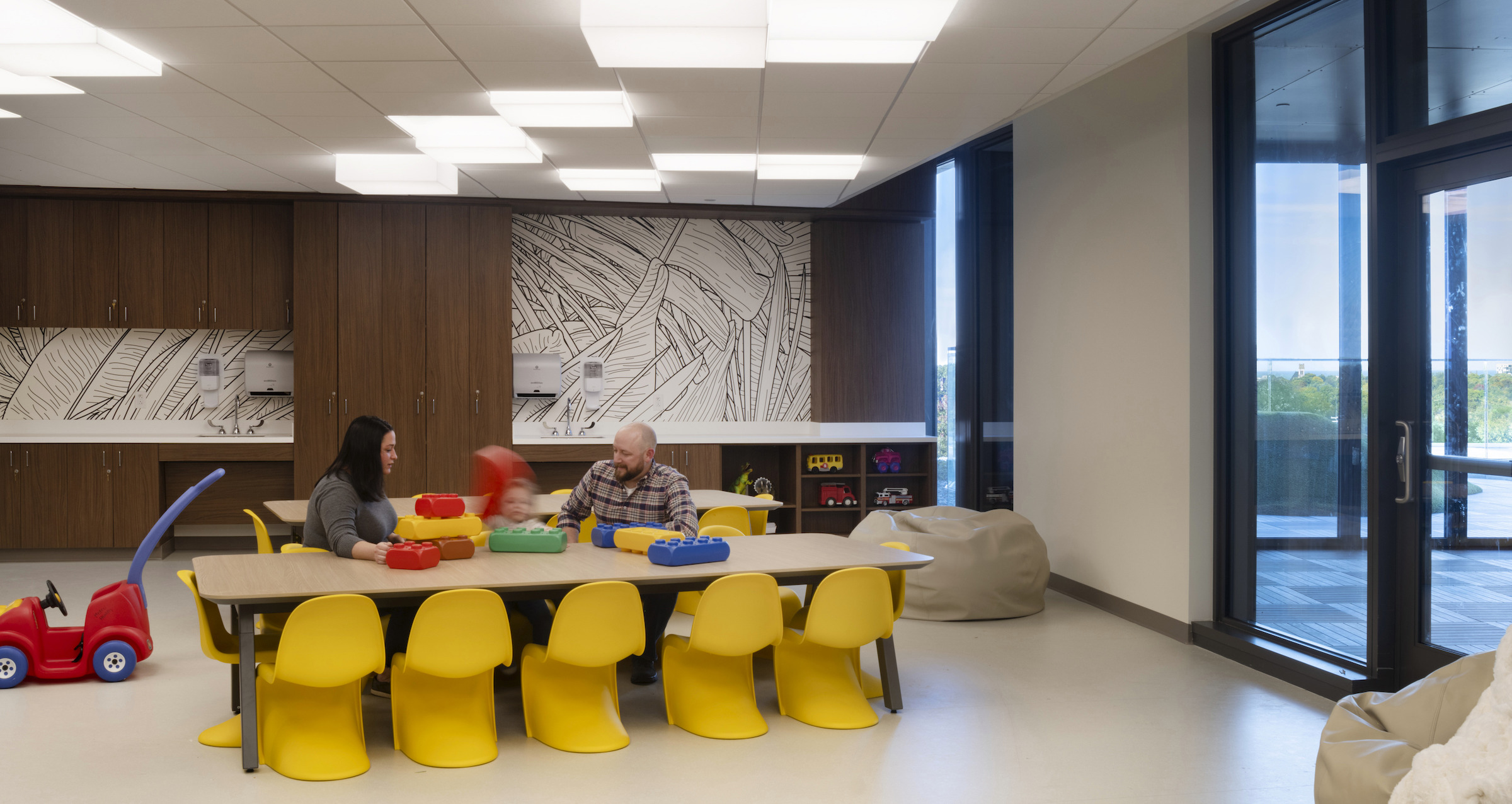
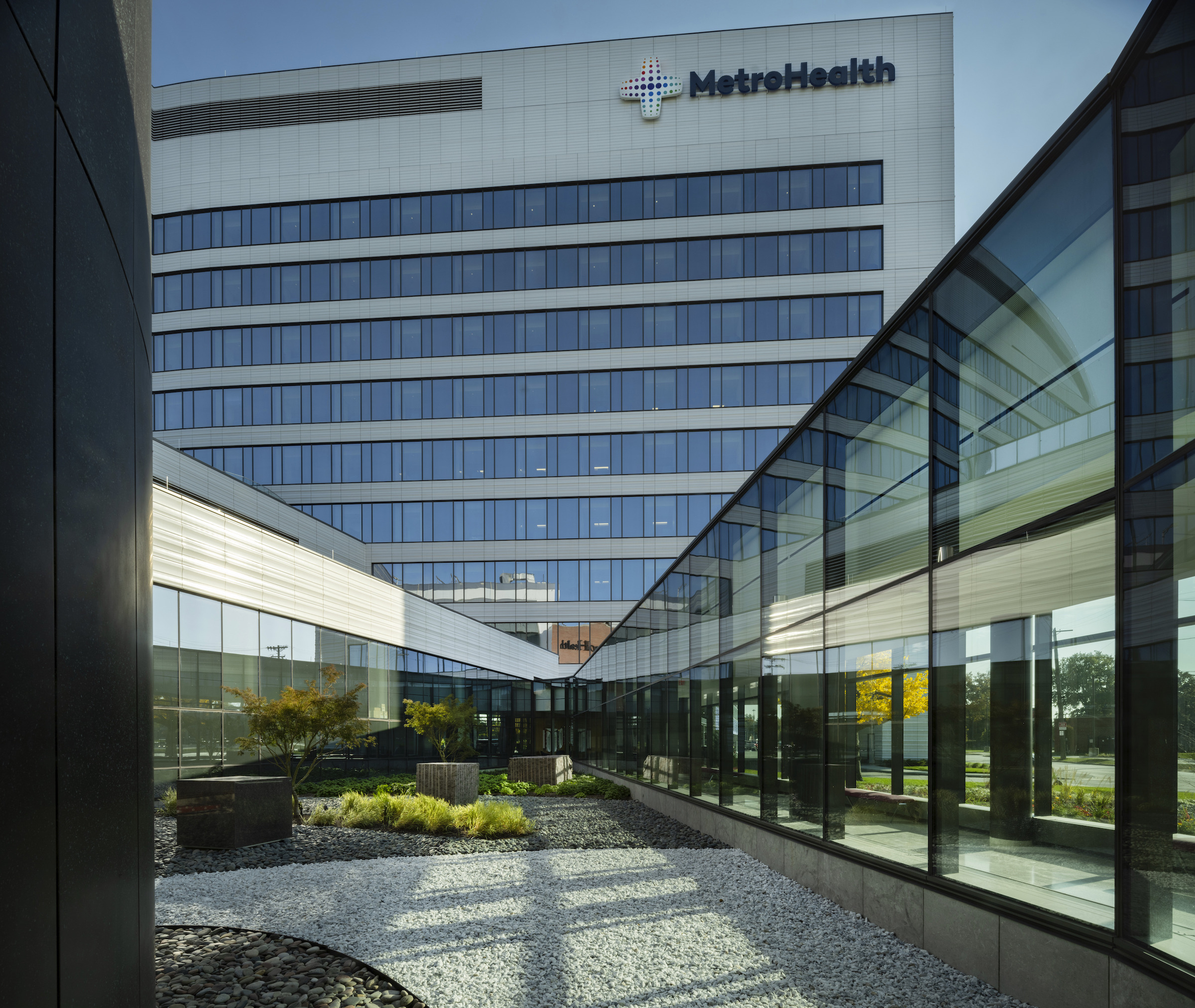

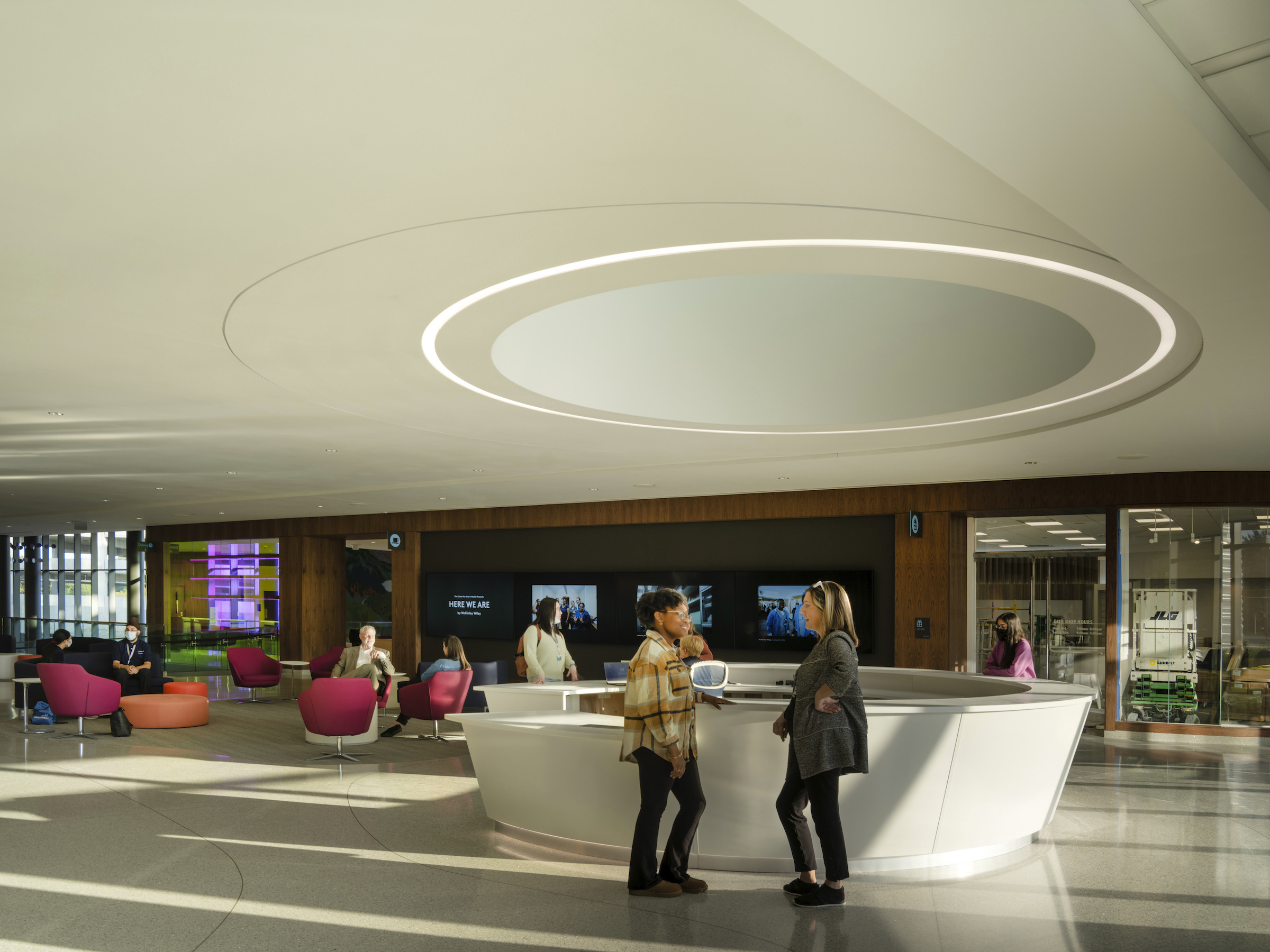
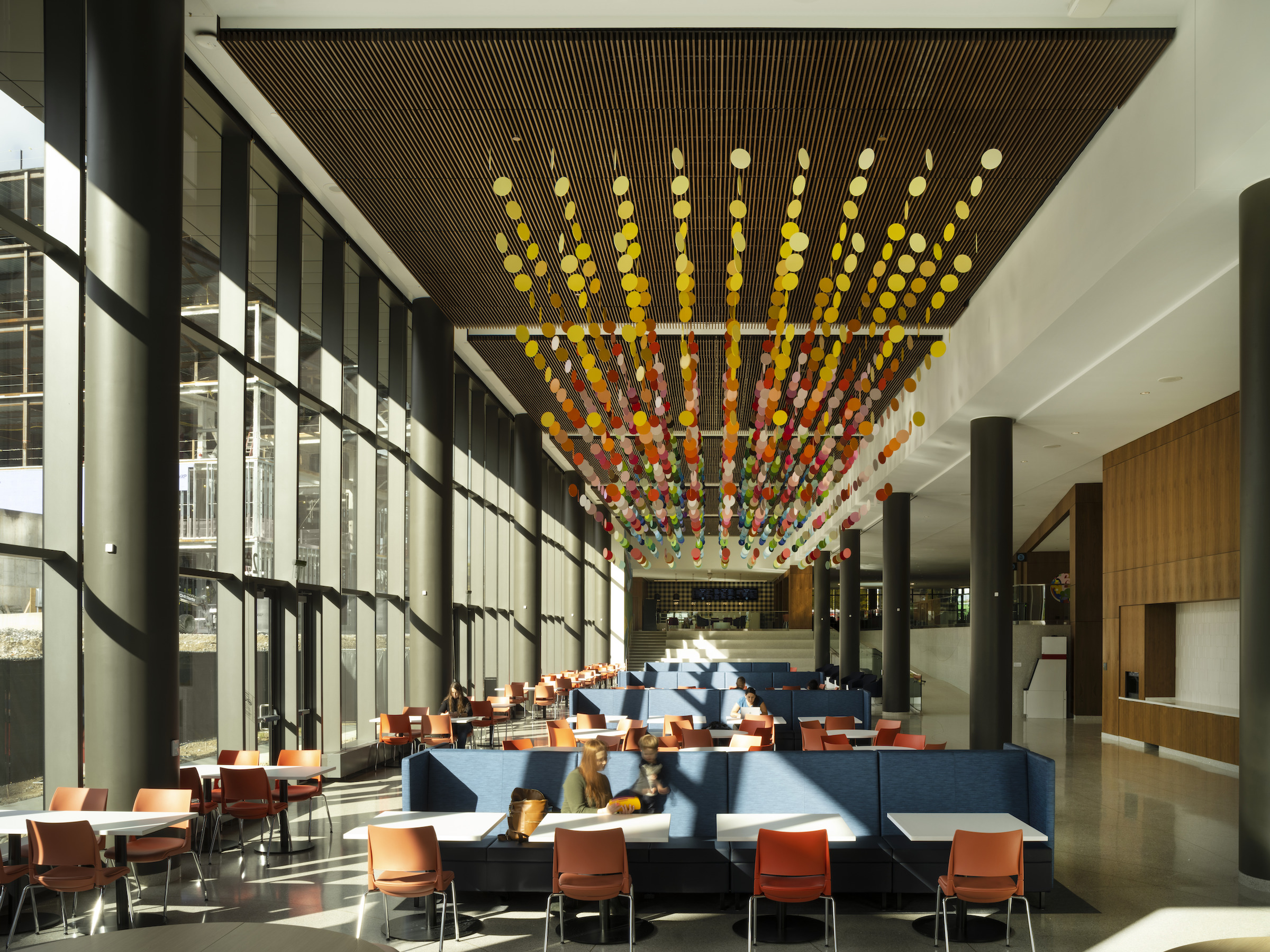
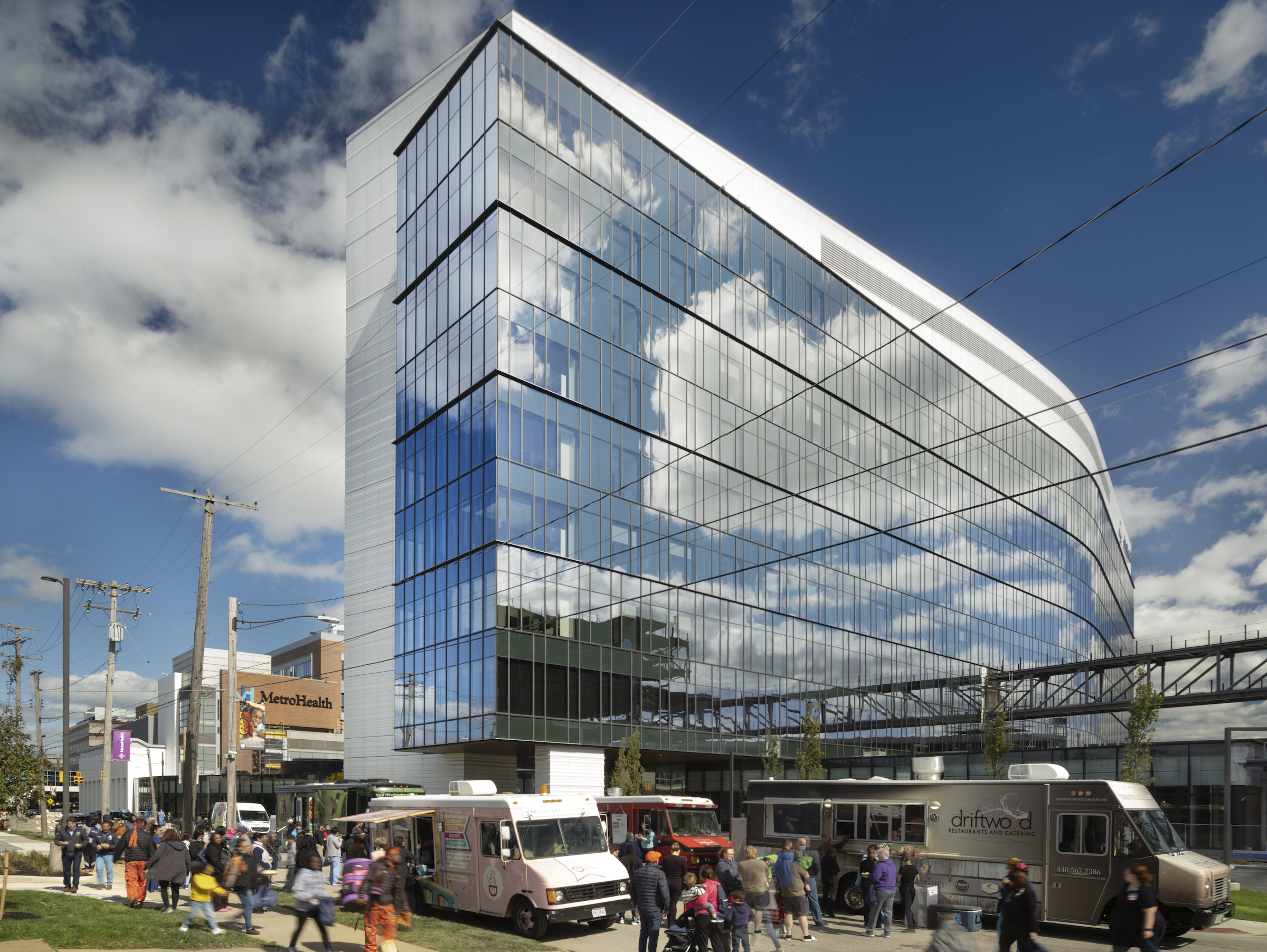
Related Stories
| Sep 9, 2014
Using Facebook to transform workplace design
As part of our ongoing studies of how building design influences human behavior in today’s social media-driven world, HOK’s workplace strategists had an idea: Leverage the power of social media to collect data about how people feel about their workplaces and the type of spaces they need to succeed.
| Sep 7, 2014
Ranked: Top state government sector AEC firms [2014 Giants 300 Report]
PCL Construction, Stantec, and AECOM head BD+C's rankings of the nation's largest state government design and construction firms, as reported in the 2014 Giants 300 Report.
| Sep 7, 2014
Hybrid healthcare: Revamping inefficient inpatient units to revenue-producing outpatient care
It's happening at community hospitals all over America: leadership teams are looking for ways to maintain margins by managing underutilized and non-revenue producing space. GS&P's David Magner explores nontraditional healthcare models.
| Sep 7, 2014
Behind the scenes of integrated project delivery — successful tools and applications
The underlying variables and tools used to manage collaboration between teams is ultimately the driving for success with IPD, writes CBRE Healthcare's Megan Donham.
| Sep 4, 2014
Hospital CEOs, architects sound off on state of healthcare design
Healthcare construction will continue to feel the effects of radical changes in the delivery of care, according to healthcare leaders attending the annual Summer Leadership Summit of the American College of Healthcare Architects and the AIA Academy of Architecture for Health.
| Sep 3, 2014
Ranked: Top local government sector AEC firms [2014 Giants 300 Report]
STV, HOK, and Turner top BD+C's rankings of the nation's largest local government design and construction firms, as reported in the 2014 Giants 300 Report.
| Sep 3, 2014
New designation launched to streamline LEED review process
The LEED Proven Provider designation is designed to minimize the need for additional work during the project review process.
| Sep 2, 2014
Ranked: Top green building sector AEC firms [2014 Giants 300 Report]
AECOM, Gensler, and Turner top BD+C's rankings of the nation's largest green design and construction firms.
| Sep 1, 2014
Ranked: Top federal government sector AEC firms [2014 Giants 300 Report]
Clark Group, Fluor, and HOK top BD+C's rankings of the nation's largest federal government design and construction firms, as reported in the 2014 Giants 300 Report.
| Aug 26, 2014
6 lessons from a true IPD project: George Washington University Hospital
In its latest blog post, Skanska shares tips and takeaways from the firm's second true integrated project delivery project.


